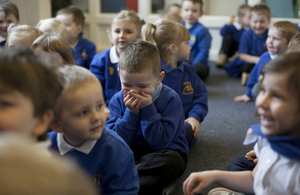Almost 9 in 10 receive first choice of primary school
This year 88% of families got a place at their first choice primary school and 85% were offered one at their first choice secondary.

Primary school pupils laughing
Official statistics published today (24 June 2014) by the Department for Education show that 546,000 (88%) families in England received a place at their first choice of primary school this year, while at secondary level over 444,000 (85%) were offered a place at their first choice school.
A Department for Education spokesperson said:
Ensuring enough school places for the growing population is one of our top priorities. That is why we have more than doubled to £5 billion the funding available to councils to create new school places, and are allowing good schools to expand without the restrictions and bureaucracy they faced in the past.
This has already led to the creation of 260,000 new school places across the country. Thanks to our reforms, the number of children in failing secondary schools has already fallen by a quarter of a million since 2010.
Overall there were more than 623,000 applications for primary school places and over 521,000 for secondary places. Almost 96% of families received a place at 1 of their top 3 preferred primary or secondary schools this year.
Today’s figures show that:
- 87.7% of pupils nationally gained an offer at their first choice of primary school, and 95.7% got 1 of their top 3 preferred schools - this is the first time statistics for primary schools have been compiled nationally and so there are no comparable figures for previous years
- 85.2% of pupils nationally received an offer at their first choice of secondary school, and 95.5% got 1 of their top 3 preferred schools - these figures are down slightly since last year but up since 2010
- the North East region has the highest number of first choice offers, 92.4% of secondary places and 91.5% of primary
Notes to editors
Primary National Offer Day was Wednesday 16 April, when families of 623,526 pupils received the results of their application for a primary school place.
Secondary National Offer Day was Monday 3 March, when families of 521,274 pupils received the results of their application for a secondary school place. Historic data for secondary schools is set out in the table below.
Year-on-year comparisons: secondary
| 2008 | 2009 | 2010 | 2011 | 2012 | 2013 | 2014 | |
|---|---|---|---|---|---|---|---|
| Number of applications received | 568,723 | 546,744 | 529,645 | 512,193 | 503,734 | 499,968 | 521,274 |
| Percentage offered a place at their highest preference school | 82.0 | 83.2 | 83.2 | 84.6 | 85.3 | 86.7 | 85.2 |
| Percentage offered a place at their second preference school | 8.7 | 8.4 | 8.6 | 8.1 | 7.8 | 7.4 | 7.7 |
| Percentage offered a place at their third preference school | 3.3 | 3.1 | 3.1 | 2.9 | 2.8 | 2.4 | 2.5 |
| Percentage offered a place at their first, second or third preference school | 94.0 | 94.6 | 94.9 | 95.6 | 95.9 | 96.5 | 95.5 |
| Percentage offered a place at a preferred school | 95.6 | 96.2 | 96.6 | 97.2 | 97.6 | 97.8 | 96.8 |
This year we are collecting data on school choices at school level for the first time. This will be published in October 2014.
This government is ensuring enough school places
Nearly 80% of new primary places created are in good or outstanding schools under this government.
Councils are on track towards creating enough places for September, with 212,000 new primary places created between May 2010 and May 2013.
We are building or improving the condition of almost 900 schools in this parliament. This includes:
- building almost 300 brand new schools, including free schools, university technical colleges and studio schools
- rebuilding and renovating 200 of the most dilapidated schools in the country through the Priority School Building Programme (PSBP)
- delivering funding for more than 400 projects from previous programmes
By contrast the last government began rebuilding or improving the condition of only 389 schools under Building Schools for the Future (BSF). The 900 school building projects approved by the coalition is central government’s largest contribution to the school estate in decades.
We set up the Priority School Building Programme to address the condition of the schools most in need of urgent repair. Through the PSBP, 261 schools will be rebuilt or have their condition needs met.
As part of the PSBP all schools will be delivered by the end of 2017 - 2 years earlier than originally planned. Given the success of the PSBP, ministers have also recently announced a second phase of the programme, worth around £2 billion.
We are building schools all at a fraction of the cost of the former government’s Building Schools for the Future programme. It was an expensive and wasteful programme that did not prioritise the most dilapidated schools.
We are providing £150 million to improve school kitchens and dining facilities as part of the introduction of universal infant free school meals.
Over the spending review period, the total capital made available for investment in schools in England will be about £18 billion.
We have opened 174 free schools which when full will provide around 80,000 places. All free schools are meeting parental demand for new schools and 7 in 10 free schools are in areas facing a shortage of school places.
The average £6.6 million cost of a free school is much smaller than the average £25 million cost for the last government’s Building Schools for the Future programme.
DfE media enquiries
Central newsdesk - for journalists 020 7783 8300